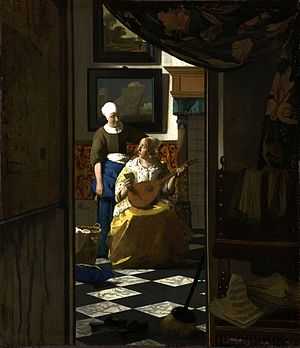The Love Letter (Vermeer)
 | |
| Artist | Jan Vermeer |
|---|---|
| Year | c. 1666 |
| Type | Oil on canvas |
| Dimensions | 44 cm × 38.5 cm (17 in × 15.2 in) |
| Location | Rijksmuseum Amsterdam, Amsterdam |
The Love Letter (Dutch: De liefdesbrief) is a 17th-century genre painting by Jan Vermeer. The painting shows a servant maid handing a letter to a young woman with a cittern. The painting is in the Rijksmuseum Amsterdam.
Description
The tied-up curtain in the foreground creates the impression that the viewer is looking at an intensely private, personal scene. There is also an element of trompe l'oeil as Dutch paintings were often hung with little curtains to conserve them, and the device of painted curtains is seen in other Dutch works of the period. The diagonals on the chequered floor create the impression of depth and three-dimensionality. The fact that it is a love letter that the woman has received is made clear by the fact that she is carrying a lute (more specifically, a cittern, a member of the lute/guitar family). The lute was a symbol of love - often carnal love; luit was also a slang term for vagina. This idea is further reinforced by the slippers at the very bottom of the picture. The removed slipper was another symbol of sex. The floor brush would appear to represent domesticity, and its placement at the side of the painting may suggest that domestic concerns have been forgotten or pushed aside.
The colors blue and gold are important in the composition of the painting - the gold is located on the woman's dress, the top of the fireplace, and many of the objects, which complements the blue on the floor, the maid's dress, the picture frames, etc., Classical influence is also apparent in the ionic columns of the fireplace.
The two paintings on the wall are also significant. The lower painting is of a stormy sea, a clear metaphor for tempestuous love. Above it is a landscape painting of a traveler on a sandy road. This may refer to the absence of the man who is writing to the lady.[1]
Provenance
In the second half of the 17th-century, the painting probably found its place in the collection of the Polish–Lithuanian Commonwealth's monarch John III Sobieski.[2] The 1696 inventory of the Wilanów Palace in Warsaw lists among Dutch paintings a painting of a lady, playing a lute in a golden robe, while a girl gives her a letter in the black frames (obraz damy, grającej na lutni w złotej szacie, a dziewczyna list jey oddaje w ramach czarnych).[2]
See also
References
- ↑ Patrick de Rynck, How to Read a Painting: Lessons from the Old Masters (Abrams: New York, 2004)
- ↑ 2.0 2.1 (English) Wanda Drecka (1977). Na tropach obrazów ze zbiorów Jana III Sobieskiego. Studia Wilanowskie I. p. 135.
Further reading
- Liedtke, Walter A. (2001). Vermeer and the Delft School. Metropolitan Museum of Art. ISBN 9780870999734.
External links
| Wikimedia Commons has media related to The Love Letter by Johannes Vermeer. |
- The Love Letter at the Rijksmuseum Amsterdam